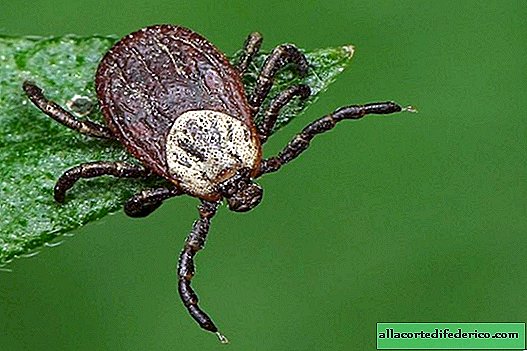Caution, spring: what to do if you are bitten by a tick
Almost all people know that ticks are carriers of dangerous diseases. But here is a situation where a person discovers a sucking tick on himself, often causes panic and confusion. What to do if you are bitten by a tick, and what could be the consequences of this unpleasant contact? After what time will the signs of a possible disease manifest themselves? So, let's see what these arthropods are dangerous and how you can protect yourself from the consequences of their bites.

For humans, ixodid ticks are a direct danger. They are common throughout the world, and carriers of dangerous diseases such as tick-borne encephalitis and tick-borne borreliosis (Lyme disease) can be found in Russia, Western and Eastern Europe, Scandinavia, Kazakhstan, Central Asia, the Caucasus, China, Canada, the United States and in many other regions. That is, you should not think that this is an exclusively Russian problem and such troubles are not waiting for you abroad.
The peak of tick activity occurs in the spring-summer period (from April to June), as well as in autumn (from August to October), when a second wave and a large number of victims are observed. People often forget about the autumn activity of ticks or simply do not know, therefore inattentive mushroom pickers, tourists and hunters become victims of these arthropods at the end of the season.
In order to protect yourself from their bites, you must wear appropriate clothing that covers all parts of the body, use repellents and regularly examine yourself and your companions. You can be vaccinated against tick-borne encephalitis, which will protect you.

But what to do if the precautionary measures did not help, and you were still bitten by a tick? First of all, you need to carefully remove it. To do this, you can use tweezers or thread and slow, swaying movements, trying not to damage the tick, remove it from the skin. It is important that the head of the arthropod does not come off and does not remain inside. Then it is necessary to treat the site of the tick bite with an available antiseptic: alcohol, zelenka, hydrogen peroxide, chlorhexidine, iodine. The tick can be placed in a reliable container and, if possible, it is better to take it to the laboratory, where it is examined for diseases. You have no more than a day to do this. This will be the best way to find out right away why you are facing an arthropod. You can also take the test yourself for tick-borne encephalitis or tick-borne borreliosis infection. If it is not possible to take an analysis, then you need to carefully monitor your well-being, at least for a month.
As for the diseases that these small arthropods carry, then everything depends on the territory in which they live. Tick-borne encephalitis and Lyam disease (tick-borne borreliosis) are most widespread. Ticks that can infect these diseases live in Russia, Europe, the USA and Canada.
Tick-borne encephalitis is best known. This is a natural focal viral infection, the carrier of which, according to statistics, are approximately 6% of ticks. In case of contact with them, you can get sick with a probability of 2 to 6%, that is, not everyone who has been bitten by an infected tick will eventually become infected with the virus. The incubation period of the disease lasts from 7 to 14 days, complications and death are possible.
Lyme disease or tick-borne borreliosis is the most common disease that is transmitted from ticks to humans, among all affected in the Northern Hemisphere. Its causative agents are bacteria of the genus Borrelia. The incubation period can be from several days to several months and even years, but most often it lasts 1-2 weeks. Acute course of the disease, death is possible.
Congo-Crimean hemorrhagic fever is common in Crimea, in the southern part of European Russia, in Ukraine, in Eastern Europe, in Central Asia, Pakistan, almost throughout Africa, with the exception of the Sahara and the territories north of it. The disease is transmitted through a tick bite, and the incubation period can last up to 14 days. Lethal outcome is possible.
Omsk hemorrhagic fever. Ticks that are carriers of this virus are common in southern Siberia: Omsk, Orenburg, Tyumen, Kurgan regions, Altai and Krasnoyarsk Territory, Northern Kazakhstan. The incubation period lasts only 2-4 days.
Hemorrhagic fever with renal syndrome is the rarest of all the diseases encountered and is common in Eurasia. The incubation period lasts from 2 to 14 days, but sometimes reaches 50 days.
All these diseases are accompanied by a sharp increase in temperature, and this should alert if a person has had contact with a tick in the recent past.

Going on a hiking trip or a trip to the picturesque corners of our country, remember that almost everywhere you can meet ticks. If you are planning a trip to the mountains, keep in mind that spring arrives there late, and the peak of the tick-borne season varies depending on the region and the absolute height of the terrain. It is necessary to take care in advance of vaccination against tick-borne encephalitis, which is done 2 months before the alleged contact with the virus carrier. Any travel company organizing vacations is required to insure you, including in case of a tick bite. Be sure to check this when filling out documents, because it is with this insurance that you will be provided with medical assistance, if necessary.
It should also be remembered that ticks can be dangerous for pets. Most often, their victims are dogs, our faithful friends accompanying us in nature. Moreover, dogs suffer from several other diseases that carry ticks. The most dangerous for dogs is pyroplasmosis, from which, without appropriate treatment, in 100% of cases a fatal outcome occurs already for 3-5 days. Therefore, if a tick is detected on an animal and any signs of malaise, it is necessary to consult a veterinarian. In any large animal clinic, your pet will be tested for blood and diagnosed.

















